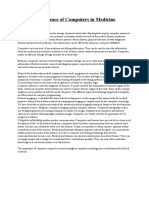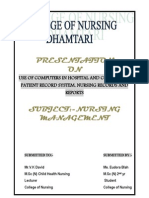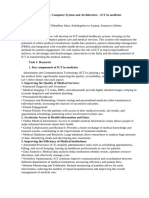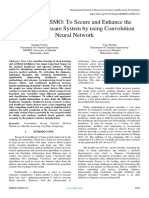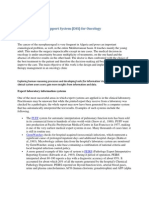0 ratings0% found this document useful (0 votes)
60 viewsSsssssssssssssssssssssss
Ssssssssssssssssssssssss
Uploaded by
fatima ghaffarThe document discusses six common uses of computers in healthcare: managing patient records and prescribing medication, aiding diagnosis, enabling telemedicine, assisting with surgical procedures, facilitating communication between practitioners and patients, and performing medical imaging procedures.
Copyright:
© All Rights Reserved
Available Formats
Download as DOCX, PDF, TXT or read online from Scribd
Ssssssssssssssssssssssss
Ssssssssssssssssssssssss
Uploaded by
fatima ghaffar0 ratings0% found this document useful (0 votes)
60 views3 pagesThe document discusses six common uses of computers in healthcare: managing patient records and prescribing medication, aiding diagnosis, enabling telemedicine, assisting with surgical procedures, facilitating communication between practitioners and patients, and performing medical imaging procedures.
Original Title
ssssssssssssssssssssssss
Copyright
© © All Rights Reserved
Available Formats
DOCX, PDF, TXT or read online from Scribd
Share this document
Did you find this document useful?
Is this content inappropriate?
The document discusses six common uses of computers in healthcare: managing patient records and prescribing medication, aiding diagnosis, enabling telemedicine, assisting with surgical procedures, facilitating communication between practitioners and patients, and performing medical imaging procedures.
Copyright:
© All Rights Reserved
Available Formats
Download as DOCX, PDF, TXT or read online from Scribd
Download as docx, pdf, or txt
0 ratings0% found this document useful (0 votes)
60 views3 pagesSsssssssssssssssssssssss
Ssssssssssssssssssssssss
Uploaded by
fatima ghaffarThe document discusses six common uses of computers in healthcare: managing patient records and prescribing medication, aiding diagnosis, enabling telemedicine, assisting with surgical procedures, facilitating communication between practitioners and patients, and performing medical imaging procedures.
Copyright:
© All Rights Reserved
Available Formats
Download as DOCX, PDF, TXT or read online from Scribd
Download as docx, pdf, or txt
You are on page 1of 3
Here are six common uses for computers in healthcare.
1. Medication and treatment
Healthcare professionals review and prescribe medications using electronic health
records. They also use apps and software programs to manage patient records. This
technology not only boosts staff efficiency, but it also helps to prevent human error.
After a medical facility has assigned an identification number to a patient, staff can
retrieve all information about that patient from a secure database. Computers can also
document treatment, medication, and care recommendations.
Mobile device apps help nurses update patient records using treatment and diagnostic
codes, as opposed to whiteboards and paper charts.
2. Patient diagnosis
Doctors use computers to manage and record patient information, which can help them
to make a more accurate diagnosis, especially if multiple doctors are working with the
same patient.
Nurses can also use technology to perform routine health checks such as EKGs,
oxygen levels, and blood pressure. Results automatically save to an electronic
database, ensuring that they are both accurate and readily available for other staff
involved in the patient’s treatment.
3. Telemedicine
There are thousands of people in the United States who do not have access to
adequate healthcare. Technology has bridged the gap between low-income patients
and doctors.
Telemedicine enables people to discuss their health concerns with a general
practitioner over the phone or via video. These doctors can then advise patients on
whether to seek help at a medical facility.
Telemedicine is also helpful for the disabled and the elderly who may find it more
difficult to travel to their doctor. Telemedicine systems also enable doctors to record and
store information electronically.
4. Surgical procedures
Surgeons carry out many advanced surgical procedures using a computer. This process
is known as Computer Assisted Surgery, or CAS, and is quickly becoming popular in
the medical field. CAS combines computer intelligence with medical expertise to assist
surgeons during complex operations.
CAS systems create and analyze a virtual model of the patient before surgery.
Surgeons then use this image to simulate the surgical procedure. In some cases, the
surgery is either performed or assisted by a robot.
5. Communication and sharing information
Computer technology can also help to communicate and share knowledge between
medical practitioners and patients. Sharing updates and research within the medical
field is made more efficient by computers and the internet.
Doctors also use the internet to offer or obtain advice. Medical practitioners from all over
the world discuss issues on medical forums, write articles about the latest advances,
and contribute to the information contained in medical journals.
6. Medical imaging
Advanced medical imaging equipment can now create three-dimensional images of
body parts. Use cases include mammography, ultrasonography, magnetic resonance
imaging (MRI), and 3D x-rays. Medical staff store these images in a computer
database, making them easy to retrieve later.
You might also like
- Homeopathy Books and Authors PDFDocument52 pagesHomeopathy Books and Authors PDFPrasad javvaji80% (5)
- Use of Computers in Hospital and CommunityDocument7 pagesUse of Computers in Hospital and CommunityDelphy Varghese100% (1)
- Design and Implementation of Electronic Medical Diagnosis System1Document50 pagesDesign and Implementation of Electronic Medical Diagnosis System1Shaguolo O. JosephNo ratings yet
- Benelli TNT600SDocument212 pagesBenelli TNT600S张连杉No ratings yet
- Health Systems and Technology: Course Number: CIS 1200 Dowling CollegeDocument11 pagesHealth Systems and Technology: Course Number: CIS 1200 Dowling CollegecleodeesNo ratings yet
- Advantages and DisadvantagesDocument2 pagesAdvantages and DisadvantagesJewel Berbano II100% (1)
- Benefits of Computer Use in Health Care Systems PDFDocument3 pagesBenefits of Computer Use in Health Care Systems PDFAnonymous DlESilj50% (4)
- Importance of Computers in MedicineDocument1 pageImportance of Computers in MedicineAlina MihaelaNo ratings yet
- Importance of Computer Sciencee in MedecineDocument1 pageImportance of Computer Sciencee in MedecineTadiambaNo ratings yet
- 5 Benefits of Technology in HealthcareDocument2 pages5 Benefits of Technology in HealthcareCHUAH TZE YEE MoeNo ratings yet
- 34274-X Benefits of Implementing Advanced Tech in Healthcare FacilitiesDocument12 pages34274-X Benefits of Implementing Advanced Tech in Healthcare Facilitiesnosheena.zeeshanNo ratings yet
- Role of Information Technology in MedicineDocument7 pagesRole of Information Technology in MedicineFahadghaznavi100% (1)
- Group 4 Nursing InformaticsDocument5 pagesGroup 4 Nursing InformaticsMj GalanoNo ratings yet
- مهارات الحاسب الالي PDFDocument49 pagesمهارات الحاسب الالي PDFLOLO Lolo0% (1)
- Final Use Computer in Hospital and CommunityDocument20 pagesFinal Use Computer in Hospital and CommunityParul Pandey86% (7)
- TechnologyDocument2 pagesTechnologyCover PakistanNo ratings yet
- Computers in Health BY Group MDocument25 pagesComputers in Health BY Group MUsman Suleman Ahmad100% (1)
- Tablanza-Finals Activity 1 (Lab)Document3 pagesTablanza-Finals Activity 1 (Lab)trust nobodyNo ratings yet
- The Impact of Digital Technology On HealthcareDocument2 pagesThe Impact of Digital Technology On HealthcareArthur LemosNo ratings yet
- ENGLISH EssayDocument3 pagesENGLISH EssayDaniyal AhmadNo ratings yet
- INFORMATICS Text For Review On QuizDocument4 pagesINFORMATICS Text For Review On QuizjimwelluismNo ratings yet
- AI in HealthcareDocument12 pagesAI in HealthcareDharshan KumarNo ratings yet
- Assignment 1Document9 pagesAssignment 1qasholiqNo ratings yet
- 7 Reasons Your Company Should Use A Digital Healthcare SolutionDocument5 pages7 Reasons Your Company Should Use A Digital Healthcare SolutionMocDocNo ratings yet
- BIOETHICS (Acitivity 2 - Finals)Document5 pagesBIOETHICS (Acitivity 2 - Finals)Cameron De GuzmanNo ratings yet
- A SphygmomanometerDocument3 pagesA Sphygmomanometerdeepesh288No ratings yet
- Informatics Lesson 1Document9 pagesInformatics Lesson 1raj.insigneNo ratings yet
- Patient Management System (New Reviewed)Document39 pagesPatient Management System (New Reviewed)Ajewole Eben Tope100% (1)
- Process of Admission, Discharge, Transfer With Utilization of TechnologyDocument7 pagesProcess of Admission, Discharge, Transfer With Utilization of TechnologyCarlo A. OropesaNo ratings yet
- Healthcare AnalyticsDocument27 pagesHealthcare AnalyticsRohit HawaldarNo ratings yet
- Health InformaticsDocument29 pagesHealth Informaticswatson191No ratings yet
- NCM 110a Elearning Notes PrelimsDocument77 pagesNCM 110a Elearning Notes PrelimsJohn Harvey GuillermoNo ratings yet
- Application of Computer in PharmacyDocument12 pagesApplication of Computer in PharmacyGhanshyam Parmar67% (3)
- The Guide To The Future of Medicine White PaperDocument25 pagesThe Guide To The Future of Medicine White PaperJose Avila100% (5)
- FARM NoteDocument12 pagesFARM NoteAsghar KhanNo ratings yet
- Ijet V3i6p2Document6 pagesIjet V3i6p2International Journal of Engineering and TechniquesNo ratings yet
- Bari 11Document104 pagesBari 11etsabayomiNo ratings yet
- Artificial Intelligence in Medical Application: Electrical and Electronic Engineering DepartmentDocument18 pagesArtificial Intelligence in Medical Application: Electrical and Electronic Engineering Departmentمهيمن الابراهيميNo ratings yet
- gjmbsv3n3spl 14Document25 pagesgjmbsv3n3spl 14areeb khanNo ratings yet
- Nursing Tics Lecture NotesDocument4 pagesNursing Tics Lecture NotesMichael Gustilo100% (1)
- Health CNN-SMO: To Secure and Enhance The Medical Healthcare System by Using Convolution Neural NetworkDocument4 pagesHealth CNN-SMO: To Secure and Enhance The Medical Healthcare System by Using Convolution Neural NetworkInternational Journal of Innovative Science and Research TechnologyNo ratings yet
- NCM 110 L1Document15 pagesNCM 110 L1QiannaNo ratings yet
- CHAPTER V-Nursing Informatics System - BSN 2A - GROUP 5Document11 pagesCHAPTER V-Nursing Informatics System - BSN 2A - GROUP 5Ericka Bayle100% (1)
- Technology (Computer) and Nursing WorkDocument6 pagesTechnology (Computer) and Nursing WorkEfjayNo ratings yet
- Expert Laboratory Information SystemsDocument8 pagesExpert Laboratory Information SystemsVeera ManickamNo ratings yet
- It in MedicineDocument4 pagesIt in MedicineHarini M 19BEE1098No ratings yet
- Technology in Nursing - Essay Example For FreeDocument8 pagesTechnology in Nursing - Essay Example For Freemyaqoob3317No ratings yet
- Hgrid: An Economical Model For Mass-Health Care System Using Latest Technology (Grid Computing)Document5 pagesHgrid: An Economical Model For Mass-Health Care System Using Latest Technology (Grid Computing)IJMERNo ratings yet
- Online Patients Record Platform Using PHPDocument31 pagesOnline Patients Record Platform Using PHPAmaan B EydreesNo ratings yet
- Electronic Health Records and Information TechnologyDocument7 pagesElectronic Health Records and Information TechnologyBiancaGabatinoAbarcaNo ratings yet
- Patient Record TrackingDocument85 pagesPatient Record TrackingMajestyNo ratings yet
- E-AMBULANCE: Real-Time Integration Platform For Heterogeneous Medical Telemetry SystemDocument8 pagesE-AMBULANCE: Real-Time Integration Platform For Heterogeneous Medical Telemetry SystemNourhene EllouzeNo ratings yet
- Computers in Medical FieldDocument14 pagesComputers in Medical Fieldsharul11No ratings yet
- Healthcare and Therefore The Internet of ThingsDocument7 pagesHealthcare and Therefore The Internet of Thingsrishabh arora rishabhNo ratings yet
- College of Computer and Information Sciences: Polytechnic University of The UniversityDocument15 pagesCollege of Computer and Information Sciences: Polytechnic University of The UniversityRrjer Jahj Rollon CuevasNo ratings yet
- Nursing InformaticsDocument8 pagesNursing InformaticsWac GunarathnaNo ratings yet
- Assignment Title: Student's NameDocument11 pagesAssignment Title: Student's NameGaurav SharmaNo ratings yet
- Emerging Technologies HealthcareDocument5 pagesEmerging Technologies Healthcarenuhaminteferi940No ratings yet
- Digital TransformationDocument17 pagesDigital TransformationLogaNathanNo ratings yet
- CourseWork3 1Document17 pagesCourseWork3 1Tir Mcdohl100% (1)
- Computers and NursingDocument5 pagesComputers and NursingZharah Ruz100% (1)
- Clinical Decision Support System: Fundamentals and ApplicationsFrom EverandClinical Decision Support System: Fundamentals and ApplicationsNo ratings yet
- Karachi Port Tower Complex: National ProjectDocument10 pagesKarachi Port Tower Complex: National Projectfatima ghaffarNo ratings yet
- Federal Urdu University of Arts, Science and Technology, IslamabadDocument4 pagesFederal Urdu University of Arts, Science and Technology, Islamabadfatima ghaffarNo ratings yet
- Environmental Chemistry Lec2Document4 pagesEnvironmental Chemistry Lec2fatima ghaffarNo ratings yet
- Project Resource Management: Acquire ResourcesDocument12 pagesProject Resource Management: Acquire Resourcesfatima ghaffarNo ratings yet
- Environmental Chemistry Lec2Document4 pagesEnvironmental Chemistry Lec2fatima ghaffarNo ratings yet
- U Shapes HotelDocument11 pagesU Shapes Hotelfatima ghaffarNo ratings yet
- Coloum: Status ID# Type Category Threat/opertunity Event Descretion Create Status Assumption Risk Owner UpdatesDocument2 pagesColoum: Status ID# Type Category Threat/opertunity Event Descretion Create Status Assumption Risk Owner Updatesfatima ghaffarNo ratings yet
- Uber Mini ProjectDocument8 pagesUber Mini Projectfatima ghaffarNo ratings yet
- Fatima Ghaffar Project CharterDocument11 pagesFatima Ghaffar Project Charterfatima ghaffarNo ratings yet
- Onlineadvt JR Jan2018Document4 pagesOnlineadvt JR Jan2018AjayNo ratings yet
- List of Malaysian StandardDocument73 pagesList of Malaysian StandardIzzat100% (2)
- Cognitive TherapyDocument7 pagesCognitive TherapyMavi YalongNo ratings yet
- Manual Taller Daewoo NubiraDocument173 pagesManual Taller Daewoo NubiraFrancisco Parada OrellanaNo ratings yet
- Suggestions in Culinary ChemistryDocument82 pagesSuggestions in Culinary ChemistryBianca PradoNo ratings yet
- Isoflavonoids of The LeguminosaeDocument48 pagesIsoflavonoids of The LeguminosaeRomário CerqueiraNo ratings yet
- Adult AutismDocument6 pagesAdult AutismEdl ZsuzsiNo ratings yet
- Translated FirDocument5 pagesTranslated FirMohammed Farhan KhanNo ratings yet
- Emily Peralta-Sosa - Capstone Paper Rough DraftDocument4 pagesEmily Peralta-Sosa - Capstone Paper Rough Draftapi-606449019No ratings yet
- Status of Solid Waste Management in The Philippines: BackgroundDocument2 pagesStatus of Solid Waste Management in The Philippines: BackgroundMichelle Tannagan100% (1)
- Abdominal Examination Guide - MRCPCH Clinical RevisionDocument16 pagesAbdominal Examination Guide - MRCPCH Clinical Revisionbairdman12No ratings yet
- Diabetes MellitusDocument85 pagesDiabetes MellitusPriyanka Hr GowdaNo ratings yet
- Nutrition: Information ManualDocument136 pagesNutrition: Information ManualTapan ChowdhuryNo ratings yet
- Understanding The High-Grade Iron Ore MarketDocument22 pagesUnderstanding The High-Grade Iron Ore MarketIzzul Azmi100% (2)
- 1925 Drinks Long Short by Nina Toye and A H AdairDocument92 pages1925 Drinks Long Short by Nina Toye and A H AdairGergely IllésNo ratings yet
- Byk Le-G 1 enDocument11 pagesByk Le-G 1 enHelene Di marcantonioNo ratings yet
- Meyyappan 2019 IOP Conf. Ser. Mater. Sci. Eng. 561 012064Document7 pagesMeyyappan 2019 IOP Conf. Ser. Mater. Sci. Eng. 561 012064shivanand hippargaNo ratings yet
- Iherb Receipt: Shipping Address: Billing AddressDocument1 pageIherb Receipt: Shipping Address: Billing AddressRedefine PlusNo ratings yet
- Death in The KitchenDocument34 pagesDeath in The KitchenMayra VillegasNo ratings yet
- 14 Building Works Dismantaling DemolishingDocument5 pages14 Building Works Dismantaling Demolishingpratimatamrakar48No ratings yet
- T Enclosure Series Spec (98909) D.2-1595820Document2 pagesT Enclosure Series Spec (98909) D.2-1595820Dadang IbnuNo ratings yet
- Optha Neet PGDocument48 pagesOptha Neet PGTeth AdamNo ratings yet
- Burger Boy Sporty GirlDocument64 pagesBurger Boy Sporty GirlRoshni MahapatraNo ratings yet
- Global Nursing Pediatrics. Nclex - RNDocument14 pagesGlobal Nursing Pediatrics. Nclex - RNNANANo ratings yet
- Survey ReportDocument45 pagesSurvey ReportvenkyniyerNo ratings yet
- 13thc Glass ManufactureDocument7 pages13thc Glass ManufactureflorenciacolomboNo ratings yet
- 2 R100004897E - PML145 (S Series) Traction Machine Installation and Maintenance Manual - ADocument32 pages2 R100004897E - PML145 (S Series) Traction Machine Installation and Maintenance Manual - AStefan HoNo ratings yet
- Steroids: Prepared By: Nimra MazharDocument34 pagesSteroids: Prepared By: Nimra MazharErum JanNo ratings yet







